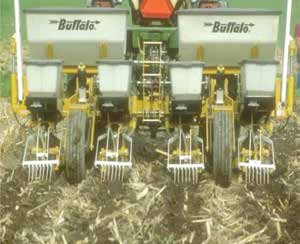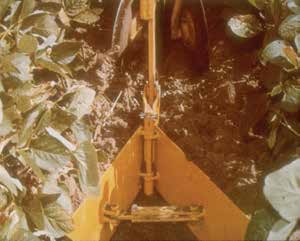chAPter 16 reduCing tillage
Figure 16.8. Left: A zone-tillage tool with hilling disks and rolling basket to create a zone of loosened soil. Right: Strip tillage also results in a narrow tilled zone that leaves most of the soil surface undisturbed. Photos by Robert Schindelbeck.
continually improved.
on the front (figure 16.9). The planter creates a fine seed-
The quality of no-tilled soil improves over time, as
bed approximately 6 inches wide by 4 inches deep and
seen in table 16.2, which compares physical, chemical,
uses trash wheels to move residue away from the row.
and biological soil health indicators after thirty-two
Zone tillage provides soil quality improvements similar
years of plow and no tillage in a New York experiment.
to those of no tillage, but it is more energy intensive. It is
The beneficial effects of no tillage are quite consistent
generally preferred over strict no-tillage systems on soils
for physical indicators, especially with aggregate stabil-
that have compaction problems (for example, fields that
ity. Biological indicators are similarly more favorable
receive liquid manure or where crops are harvested when
for no tillage, and organic matter content is 35% higher
the soil is susceptible to compaction) and in humid and
than with plow tillage. The effects are less apparent
cold climates, where removal of residue from the row is
for chemical properties, except the pH is slightly more
desirable for soil drying and warm-up.
favorable for no-till, and the early-season nitrate con-
centration is 50% higher. Other experiments have also
demonstrated that long-term reduced tillage increases
nitrogen availability from organic matter, which may
result in significant fertilizer savings.
Zone, strip, and ridge tillage. Zone-, strip-, and
ridge-tillage systems are adapted to wide-row crops with
30-inch spacing or more. Their approach is to disturb
the soil in a narrow strip along the plant row and leave
most of the soil surface undisturbed. Zone tillage involves
e d c f b
a
the use of a zone builder (figure 16.8, left), which creates
a loosened band that extends into the subsoil (12 to 16
Figure 16.9. Zone-till planter: (a) coulters (cut up residues and break up inches). This “vertical tillage” approach promotes deeper
soil in seed zone); (b) fertilizer disk openers (place granular starter fertil-
izer in a band next to the seed); (c) spider (trash) wheels (move residue
root growth and water movement. This is followed by a
away from the row); (d) seed placement unit; (e) press wheels (create firm
row crop planter with multiple fluted coulters mounted
seedbed); and (f) wheel used for transporting the planter.
181
Building SoilS for Better CropS: SuStainaBle Soil ManageMent







